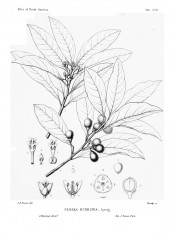Persea borbonia (L.) Spreng.
Frost hardy deciduous tree with lance-shaped leaves, to 7.5cm long, and yellow and green flowers followed by dark blue fruits. To 12m. [RHSD, Hortus, Hilliers’].
Horticultural & Botanical History
‘Persea Borbonia is a common inhabitant of the borders of streams and swamps,where, in company with the Live Oak, the Water Oak, the Spanish Oak, the Cuban Pine, and the Hickories, it usually grows in rich moist soil; or occasionally it is found in dry sandy loam in the shade of forests of the Long-leaved Pine. The Red Bay is distributed through the coast regions of the south Atlantic and Gulf states from Virginia to the shores of Bay Biscayne and Cape Romano in Florida and to the valley of the Brazos River in Texas, and west of the Mississippi River extends northward through Louisiana to southern Arkansas.
The wood of Persea Borbonia is heavy, hard, very strong although rather brittle, close-grained, and susceptible of receiving a beautiful polish; it contains numerous thin medullary rays and many evenly distributed open ducts, and is bright red, with thin lighter colored sapwood composed of four or five layers of annual growth. The specific gravity of the absolutely dry wood is 0.6429, a cubic foot weighing 40.07 pounds. It is occasionally used for cabinet-making and in the interior finish of houses, for which its strength, hardness, and bright color make it valuable. Formerly it was employed in ship and boat building.
The Red Bay was first described in the Natural History of Carolina by Mark Catesby, who probably introduced it into English gardens, as it was cultivated by Philip Miller as early as 1739 in the Physic Garden at Chelsea near London.
Although it is one of the most beautiful and valuable of the evergreen trees of the North American forests, the Red Bay has been neglected as an ornament for parks and gardens, and is now rarely seen in cultivation.’ [Sargent – The Silva of North America p.4, pl.CCCI/1895].
History at Camden Park
Listed in all published catalogues [T.628/1843].
Notes
Laurus borbonia Sw. (1798) = Nectandra antillana Meisn.
Laurus borbonia Hort. ex Meisn. (1862) = Laurus canariensis Willd. + Apollonias canariensis Nees
Laurus borbonia Lam. = Oreodaphne martiniana Nees
Published Mar 07, 2009 - 04:56 PM | Last updated Jul 25, 2010 - 04:13 PM
| Family | Lauraceae |
|---|---|
| Category | |
| Region of origin | Eastern North America |
| Synonyms |
|
| Common Name | Carolina laurel, Bull bay, Red bay |
| Name in the Camden Park Record | Laurus Borbonia |
| Confidence level | high |


